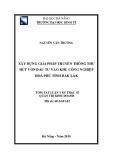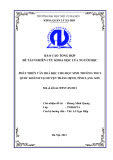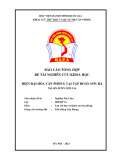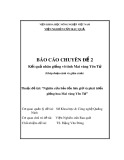
Expression of the V-ATPase proteolipid subunit of
Acetabularia
acetabulum
in a
VMA3
-deficient strain of
Saccharomyces cerevisiae
and study of its complementation
Mikiko Ikeda
1
, Misato Hinohara
1
, Kimiko Umami
1
, Yuki Taguro
1
, Yoshio Okada
1
,YohWada
2
,
Yoichi Nakanishi
3
and Masayoshi Maeshima
3
1
Department of Nutritional Science, Faculty of Health and Welfare Science, Okayama Prefectural University, Soja, Japan;
2
Division of
Biological Science, Institute of Scientific and Industrial Research, Osaka University, Japan;
3
Laboratory of Cell Dynamics, Graduate
School of Bioagricultural Sciences, Nagoya University, Japan
The function of the translation products of six different
cDNAs for Acetabularia V-ATPase proteolipid subunit
(AACEVAPD1 to AACEVAPD6 ) was examined using a
Saccharomyces cerevisiae VMA3-deficient strain that lacked
its own gene for one of the proteolipid subunits of
V-ATPase. Expression of the cDNAs in the strain revealed
that four cDNAs from the six complemented the proton
transport activity into the vacuole, visualized by fluor-
escence microscopy. The vacuolar-membrane-enriched
fractions from the four transformants showed cross-
reactivity with antibodies against the subunits a and A of
S. cerevisiae V-ATPase. Two translation products from the
other two cDNAs were demonstrated not to be localized in
vacuolar membranes, and thus could not complement the
function of the VMA3-deficient strain. As the primary
structures deduced from the former four cDNAs are similar
but clearly different from those of the latter two, the latter
two translation products may not be able to substitute for
theVMA3 gene product.
Keywords: proton transport; proteolipid subunit; V-ATPase;
Acetabularia acetabulum; heterologous expression.
The vacuolar H
1
-ATPase (V-ATPase) is ubiquitous both in
prokaryotes and eukaryotes. This enzyme is composed of
two domains, a large peripheral domain (V
1
) and a
membrane integral domain (V
O
). The major component of
the V
O
portioncommontoallV-ATPasesisthe
N,N0-dicyclohexylcarbodiimide-binding 16-kDa subunit
(proteolipid subunit). In higher plants, the V-ATPase has
been well characterized biochemically and at the molecular
level [1]. Its physiological roles in plant cells are to regulate
cytoplasmic pH and ion levels, and to drive secondary active
transport of various ions and metabolites such as Ca
21
,
anions, amino acids and sugars into the vacuole. Plant
V-ATPases are large complexes (400–650 kDa) composed
of 7–10 different subunits [1]. Among these subunits, the
proteolipid subunit is present in six copies per holoenzyme
[1], which forms a functional proton channel [2].
Acetabularia acetabulum, a giant unicellular marine alga,
belongs to the Dasycladaceae family. We have already
reported the presence of V-ATPase in this organism and
demonstrated the proton-pumping activity in tonoplast-
enriched vesicles and by immunoblot analysis [3]. Three
subunits (A, B and the proteolipid subunit) form a small
multigene family encoding V-ATPase; two different cDNAs
coding the subunits A [4,5] and B [5,6], and six different
cDNAs for the proteolipid subunit [7,8] have been isolated.
In this study we focussed our attention on the function of
the translation products of six cDNAs (AACEVAPD1 to
AACEVAPD6 ) [7,8] for the proteolipid subunit of
A. acetabulum V-ATPase. By heterologous expression in a
VMA3-deficient strain of Saccharomyces cerevisiae and its
complementation study, we confirmed that four cDNAs
(AACEVAPD2,4,5and 6) encode functional proteolipid
subunits in the yeast V-ATPase complex, but two others
(AACEVAPD1 and 3) do not. In addition to the results of
immunoblot analyses, the relation between the functional
complementation and the primary structures is also
discussed.
MATERIALS AND METHODS
Yeast strains
S. cerevisiae strains YN45 [MATa, ade2 – 101,his3-
D
200,
leu2
D
1,lys2-801,trp1,ura3-52,
D
cup5(vma3)::LEU2,
pep4::HIS3], YN11 [MATa, ade2-101,his3-
D
200,leu2
D
1,
lys2-801,trp1-
D
63,ura3-52,
D
cup5 (vma3)::LEU2],
YPH499 [MATa, ade2-101,his3-
D
200,leu2
D
1,lys2-801,
trp1-
D
63,ura3-529], BJ5458 [MATa,ura3–52] [9], trp1,
lys2–801,leu2
D
1,his3
D
200,pep4::HIS3, prb1
D
1.6R,
can1,GAL] [10]. The YN11 strain was derived from
YPH499 strain, and YN45 strain was prepared by the use of
YN11 and BJ5458 strains.
Preparation of
AACEVAPD1 –6
50RACE and 30RACE products of the respective gene were
used as a template for PCR to obtain the respective full
Correspondence to M. Ikeda, Department of Nutritional Science,
Faculty of Health and Welfare Science, Okayama Prefectural
University, Kuboki 111, Soja 719-1197, Japan
(Received 23 April 2001, revised 21 September 2001, accepted
26 September 2001)
Abbreviations: V-ATPase, vacuolar H
1
-ATPase; VMA3, gene coding
for the proteolipid subunit of Saccharomyces cerevisiae V-ATPase;
GraPDH, glyceraldehyde 3-phosphate dehydrogenase.
Eur. J. Biochem. 268, 6097–6104 (2001) qFEBS 2001






























